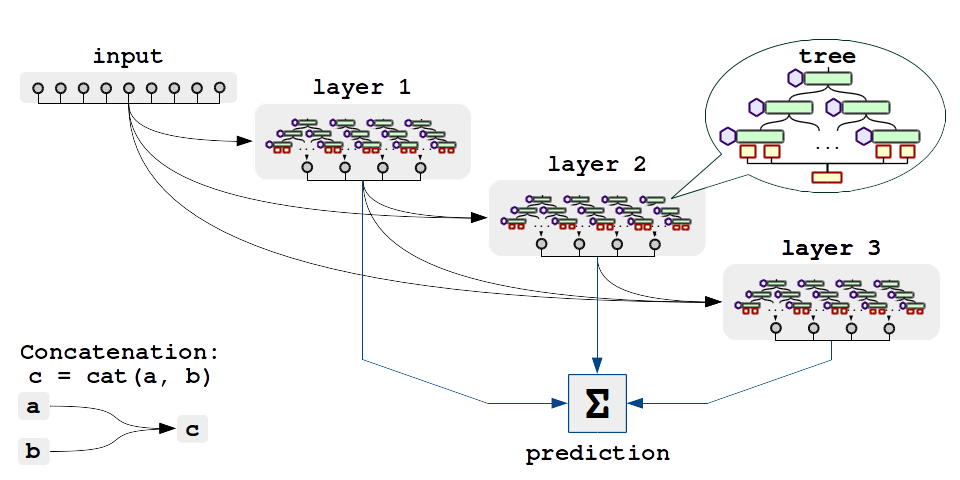Qwicen / Node
Licence: mit
Neural Oblivious Decision Ensembles for Deep Learning on Tabular Data
Stars: ✭ 323
Labels
Projects that are alternatives of or similar to Node
Recurrent Neural Networks
Learning about and doing projects with recurrent neural networks
Stars: ✭ 320 (-0.93%)
Mutual labels: jupyter-notebook
Jupyter Themer
Apply custom CSS styling to your jupyter notebooks
Stars: ✭ 322 (-0.31%)
Mutual labels: jupyter-notebook
Bdci2019 Sentiment Classification
CCF BDCI 2019 互联网新闻情感分析 复赛top1解决方案
Stars: ✭ 317 (-1.86%)
Mutual labels: jupyter-notebook
Bokeh Python Visualization
A Bokeh project developed for learning and teaching Bokeh interactive plotting!
Stars: ✭ 321 (-0.62%)
Mutual labels: jupyter-notebook
Joypy
Joyplots in Python with matplotlib & pandas 📈
Stars: ✭ 322 (-0.31%)
Mutual labels: jupyter-notebook
Probability
Probabilistic reasoning and statistical analysis in TensorFlow
Stars: ✭ 3,550 (+999.07%)
Mutual labels: jupyter-notebook
Autocrop
😌 Automatically detects and crops faces from batches of pictures.
Stars: ✭ 320 (-0.93%)
Mutual labels: jupyter-notebook
Carnd Traffic Sign Classifier Project
Classify Traffic Signs.
Stars: ✭ 323 (+0%)
Mutual labels: jupyter-notebook
Machine Learning For Trading
Code for Machine Learning for Algorithmic Trading, 2nd edition.
Stars: ✭ 4,979 (+1441.49%)
Mutual labels: jupyter-notebook
Julia Dataframes Tutorial
A tutorial on Julia DataFrames package
Stars: ✭ 318 (-1.55%)
Mutual labels: jupyter-notebook
Adanet
Fast and flexible AutoML with learning guarantees.
Stars: ✭ 3,340 (+934.06%)
Mutual labels: jupyter-notebook
Sars tutorial
Repository for the tutorial on Sequence-Aware Recommender Systems held at TheWebConf 2019 and ACM RecSys 2018
Stars: ✭ 320 (-0.93%)
Mutual labels: jupyter-notebook
Your First Machine Learning Project End To End In Python
这是一个完整的,端到端的机器学习项目,非常适合有一定基础后拿来练习,以提高对完整机器学习项目的认识
Stars: ✭ 323 (+0%)
Mutual labels: jupyter-notebook
Standalone Deeplearning
2019 KAIST 딥러닝 홀로서기 세미나용 저장소입니다.
Stars: ✭ 318 (-1.55%)
Mutual labels: jupyter-notebook
Cs329s Ml Deployment Tutorial
Code and files to go along with CS329s machine learning model deployment tutorial.
Stars: ✭ 314 (-2.79%)
Mutual labels: jupyter-notebook
Caffe Speech Recognition
Speech Recognition with the Caffe deep learning framework, migrating to
Stars: ✭ 323 (+0%)
Mutual labels: jupyter-notebook
Autoeq
Automatic headphone equalization from frequency responses
Stars: ✭ 5,989 (+1754.18%)
Mutual labels: jupyter-notebook
Neural Oblivious Decision Ensembles
A supplementary code for Neural Oblivious Decision Ensembles for Deep Learning on Tabular Data paper.

What does it do?
It learns deep ensembles of oblivious differentiable decision trees on tabular data
What do i need to run it?
- A machine with some CPU (preferably 2+ free cores) and GPU(s)
- Running without GPU is possible but takes 8-10x as long even on high-end CPUs
- Our implementation is memory inefficient and may require a lot of GPU memory to converge
- Some popular Linux x64 distribution
- Tested on Ubuntu16.04, should work fine on any popular linux64 and even MacOS;
- Windows and x32 systems may require heavy wizardry to run;
- When in doubt, use Docker, preferably GPU-enabled (i.e. nvidia-docker)
How do I run it?
- Clone or download this repo.
cdyourself to it's root directory. - Grab or build a working python enviromnent. Anaconda works fine.
- Install packages from
requirements.txt
- It is critical that you use torch >= 1.1, not 1.0 or earlier
- You will also need jupyter or some other way to work with .ipynb files
- Run jupyter notebook and open a notebook in
./notebooks/
- Before you run the first cell, change
%env CUDA_VISIBLE_DEVICES=#to an index that you plan to use. - The notebook downloads data from dropbox. You will need 1-5Gb of disk space depending on dataset.
We showcase two typical learning scenarios for classification and regression. Please consult the original paper for training details.
Note that the project description data, including the texts, logos, images, and/or trademarks,
for each open source project belongs to its rightful owner.
If you wish to add or remove any projects, please contact us at [email protected].
